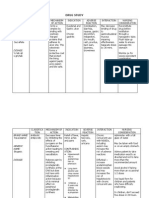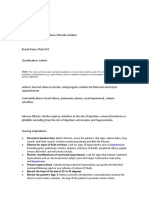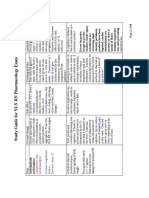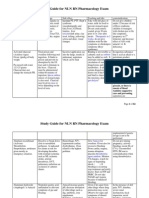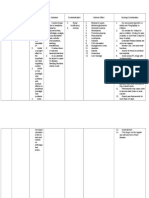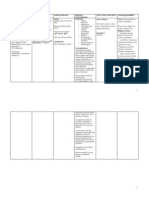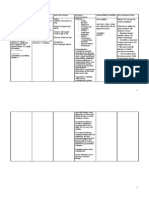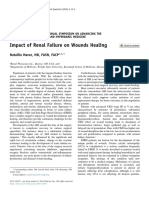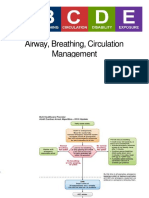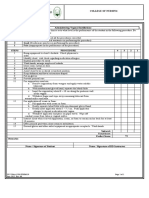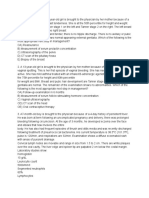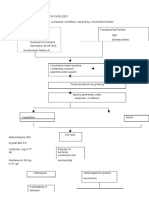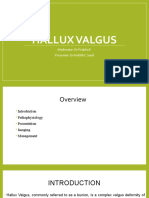DRUG ANALYSIS
DRUG Omeprazole THERAPUETIC ACTION Gastric acid-pump inhibitor: Suppresses gastric acid secretion by specific inhibition of the hydrogenpotassium ATPase enzyme system at the secretory surface of the gastric parietal cells; blocks the final step of acid production. INDICATION Short-term treatment of active duodenal ulcer First-line therapy in treatment of heartburn or symptoms of GERD Short-term treatment of active benign gastric ulcer GERD, severe erosive esophagitis, poorly responsive symptomatic GERD Long-term therapy: Treatment of pathologic hypersecretory conditions (Zollinger-Ellison syndrome, multiple adenomas, systemic mastocytosis) Eradication of H. pylori with amoxicillin or metronidazole and clarithromycin Prilosec OTC: Treatment of frequent heartburn (2 or more days per week) Unlabeled use: Posterior laryngitis; enhance efficacy of pancreatin for the treatment of steatorrhea in cystic fibrosis CONTRAINDICATION ADVERSE EFFECT NURSING CONSIDERATION Assessment History: Hypersensitivity to omeprazole or any of its components; pregnancy, lactation Physical: Skin lesions; T; reflexes, affect; urinary output, abdominal examination; respiratory auscultation Interventions Administer before meals. Caution patient to swallow capsules wholenot to open, chew, or crush them. If using oral suspension, empty packet into a small cup containing 2 tbsp of water. Stir and have patient drink immediately; fill cup with water and have patient drink this water. Do not use any other diluent. Teaching points Take the drug before meals. Swallow the capsules whole; do not chew, open, or crush them. If using the oral suspension, empty packet into a small cup containing 2 tbsp of water. Stir and drink immediately; fill cup with water and drink this water. Do not use any other liquid or food
Contraindicated with hypersensitivity to omeprazole or its components. Use cautiously with pregnancy, lactation.
CNS: Headache,
dizziness, asthenia, vertigo, insomnia, apathy, anxiety, paresthesias, dream abnormalities Dermatologic: Rash, inflammation, urticaria, pruritus, alopecia, dry skin GI: Diarrhea, abdominal pain, nausea, vomiting, constipation, dry mouth, tongue atrophy Respiratory: URI symptoms, cough, epistaxis Other: Cancer in preclinical studies, back pain, fever
�Famotidine Morhpine Sulfate Tramadol Cefazolin Arcoxia
to dissolve the packet. This drug will need to be taken for up to 8 wk (short-term therapy) or for a prolonged period (> 5 yr in some cases). Have regular medical follow-up visit.
acetaminophen
Antipyretic: Reduces fever by acting directly on the hypothalamic heat-regulating center to cause vasodilation and sweating, which helps dissipate heat. Analgesic: Site and mechanism of action unclear.
Analgesic-antipyretic in patients with aspirin allergy, hemostatic disturbances, bleeding diatheses, upper GI disease, gouty arthritis Arthritis and rheumatic disorders involving musculoskeletal pain (but lacks clinically significant antirheumatic and antiinflammatory effects) Common cold, flu, other viral and bacterial infections with pain and fever Unlabeled use: Prophylactic for children receiving DPT vaccination to reduce incidence of fever and pain
Contraindicated with allergy to acetaminophen. Use cautiously with impaired hepatic function, chronic alcoholism, pregnancy, lactation.
CNS: Headache CV: Chest pain, dyspnea, myocardial damage when doses of 58 g/day are ingested daily for several weeks or when doses of 4 g/day are ingested for 1 yr GI: Hepatic toxicity and failure, jaundice GU: Acute kidney failure, renal tubular necrosis Hematologic: Methemoglobinemia cyanosis; hemolytic anemiahematuria, anuria; neutropenia, leukopenia, pancytopenia, thrombocytopenia, hypoglycemia Hypersensitivity: Rash, fever
Assessment
History: Allergy to acetaminophen, impaired hepatic function, chronic alcoholism, pregnancy, lactation Physical: Skin color, lesions; T; liver evaluation; CBC, liver and renal function tests
Interventions
Do not exceed the recommended dosage. Consult physician if needed for children < 3 yr; if needed for longer than 10 days; if continued fever, severe or recurrent pain occurs (possible serious illness). Give drug with food if GI upset is noted. Discontinue drug if hypersensitivity reactions occur.
Teaching points
� Do not exceed recommended dose; do not take for longer than 10 days. Take the drug only for complaints indicated; it is not an anti-inflammatory agent. Report rash, unusual bleeding or bruising, yellowing of skin or eyes, changes in voiding patterns.
Prevention of hemorrhagic disease of the newborn. Anticoagulant antagonist aquamephyton
Newborn that does not receive adequate Vitamin K transplacentally and is unable to synthesize vitamin initially because of limited intestinal flora Newborns of mothers who received oral anticoagulants, anticonvulsants, antituberculosis drugs or recent antibiotics during pregnancy.
Hypersensitivity on any component of this medication
Side effects are edema and pain at injection site Allergic Reactions Urticaria Rashes
Assessment Assess the newborn from bleeding in the umbilical cord, circumcision site, nose, gastrointestinal tract, and generalized ecchymoses Planning Newborn will experience minimal or no side effects from drugs routinely administered after delivery. Interventions Protect the drug from light. Cleanse the area before injecting and observe for edema and inflammation. Teaching Points
� Instruct the client regarding the drug action, purpose and side effects. Solutions containing dextrose should be used with caution in patients with known subclinical or overt diabetes mellitus. Caution must be exercised in the administration of parenteral fluids, especially those containing sodium ions, to patients receiving corticosteroids or corticotropin. Potassium containing solutions should be used with caution in the presence of cardiac disease, particularly in digitalized patients or in the presence of renal disease. Solutions containing lactate ions should be used with caution as excess administration may result in metabolic alkalosis.
Lactated Ringers
This medication is an intravenous (IV) solution used to supply water and electrolytes (e.g., calcium, potassium, sodium, chloride), either with or without calories (dextrose), to the body. It is also used as a mixing solution (diluent) for other IV medications.
These solutions are indicated for Parenteral replacement of extracellular losses of fluid and electrolytes, with or without minimal carbohydrate calories, as required by the clinical condition of the patient.
Solutions containing lactate are NOT FOR USE IN THE TREATMENT OF LACTIC ACIDOSIS.
Reactions which may occur because of the solution or the technique of administration include febrile response, infection at the site of injection, venous thrombosis or phlebitis extending from the site of injection, extravasation and hypervolemia. If an adverse reaction does occur, discontinue the infusion, evaluate the patient, institute appropriate therapeutic countermeasures and save the remainder of the fluid for examination if deemed necessary.


